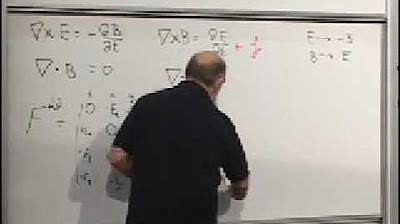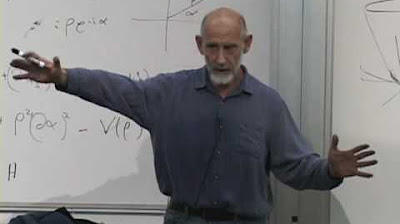Where Does Electric Charge Come From?
TLDRThis video script delves into the conservation of electric charge, a fundamental concept in physics. It explains that charge is a property of particles, linking them to the electromagnetic field. The script uses quantum mechanics to illustrate that the conservation of charge is due to an invariance in the electromagnetic interaction, termed gauge invariance. This is connected to the local phase invariance of charged particles, which is maintained by the electromagnetic potentials. The explanation is enriched with analogies and humor, making complex concepts accessible to viewers.
Takeaways
- 🔋 Electric charge is a coupling property that measures a particle's connection to the electromagnetic field.
- 🌐 Charge conservation is linked to the fundamental nature of the electromagnetic interaction and is a result of quantum mechanics principles.
- 🔢 Charge is a fundamental property of particles, with some having positive charge, some negative, and others being electrically neutral.
- 🔄 Noether's theorem states that every invariance in the universe corresponds to a conserved quantity, such as charge.
- 🛡️ The electromagnetic field is mediated by electric and magnetic fields, which are related to electric and magnetic potentials.
- 🔄 Gauge invariance is a property of the electromagnetic field where changes in the potentials do not affect the underlying fields.
- 🌊 Quantum particles like electrons are described by probability waves, and their behavior is inherently quantum mechanical.
- 🌀 Global and local phase invariance are properties of quantum waves that relate to the conservation of charge.
- 📌 The electromagnetic potentials provide charged particles with local phase invariance, which is key to their interaction with the electromagnetic field.
- 🔗 The conservation of charge is a direct consequence of the invariance in the electromagnetic interaction and the quantum mechanical nature of charged particles.
Q & A
What is the fundamental property that the term 'charge' refers to?
-Charge is a fundamental property of particles, indicating their level of coupling or linkage to the electromagnetic field. It can be positive, negative, or neutral, and is a numerical value that represents the electromagnetic interaction of particles.
Why is the conservation of electric charge important?
-The conservation of electric charge is a fundamental principle in physics that ensures the stability and predictability of the electromagnetic interactions. It is a direct consequence of the underlying symmetries and invariance in the universe, as described by Noether's theorem.
What does it mean for a quantity to be 'conserved'?
-A conserved quantity is a numerical value that remains constant over time. It implies that a particular aspect of the physical system does not change, reflecting an invariance or symmetry in the laws of physics.
What is Noether's theorem and how does it relate to charge conservation?
-Noether's theorem is a fundamental theorem in theoretical physics that states every differentiable symmetry of the action of a physical system has a corresponding conservation law. In the context of charge conservation, it means that the invariance of the electromagnetic interaction leads to the conservation of electric charge.
What is the difference between electric and magnetic fields, and how are they related to potentials?
-Electric fields exert forces on charged particles, while magnetic fields exert forces on moving charged particles. Both fields are related to potentials, specifically the electric potential (which is related to energy) and the magnetic potential (which is related to momentum). The fields can be derived from the potentials, and changes in the potentials that leave the fields unchanged are called gauge transformations.
What is gauge invariance and how does it play a role in electromagnetism?
-Gauge invariance is the property of a physical theory where the physical quantities of interest remain unchanged under certain transformations of the potentials. In electromagnetism, it is the invariance of the electric and magnetic fields under changes in the potentials that do not affect the spatial or temporal changes of the fields. This invariance is crucial for the conservation of electric charge.
How do quantum mechanics and probability waves relate to the concept of charge?
-Quantum mechanics describes the behavior of particles using probability waves, which are mathematical functions that predict the likelihood of finding a particle in a particular state or location. The concept of charge is intrinsically linked to quantum mechanics through the requirement of local phase invariance for charged particles, which is achieved through the electromagnetic potentials in their quantum wave function.
What is a global phase shift and how does it differ from a local phase shift?
-A global phase shift is a uniform change in the phase of a probability wave across all space and time. It does not affect the probability density of finding a particle at any particular location. In contrast, a local phase shift varies at different places and times, which can significantly alter the probability wave's shape and the particle's behavior.
How does the electromagnetic interaction provide local phase invariance to charged particles?
-The electromagnetic interaction provides local phase invariance to charged particles by adjusting their quantum wave function through the electromagnetic potentials. This adjustment ensures that the probability density, which determines the likelihood of finding the particle, remains invariant under local changes in phase, reflecting the particle's interaction with the electromagnetic field.
What is the significance of the adjusted Schrödinger equation in the context of charged particles?
-The adjusted Schrödinger equation is important because it extends the basic Schrödinger equation to include the effects of electromagnetic potentials. This allows the equation to describe the behavior of charged particles with non-zero spin, incorporating their electromagnetic interactions into the quantum mechanical framework.
How does the concept of local phase invariance lead to the conservation of charge?
-Local phase invariance for charged particles implies that the quantum mechanical description of these particles remains unchanged under local variations in the electromagnetic field. This invariance is a direct consequence of the particles' interaction with the electromagnetic field, and according to Noether's theorem, it leads to the conservation of electric charge, ensuring that the total charge in a closed system remains constant.
Outlines
🔋 Understanding Electric Charge
This paragraph introduces the concept of electric charge as a coupling property that measures the connection between particles and the electromagnetic field. It explains that this relationship is the reason behind the conservation of electric charge and the functioning of the electromagnetic field. The video's structure is outlined, with the ultimate goal of explaining charge conservation. The content also touches on the need for quantum mechanics to fully grasp these concepts and provides an overview of what charge means in terms of fundamental properties of particles, including their positive, negative, or neutral states.
💡 The Conservation of Charge
The second paragraph delves into the definition of a conserved quantity and its relation to invariance or symmetry in the universe, as described by Noether's theorem. It explains how different types of invariance correspond to various conserved quantities, such as linear momentum, energy, and angular momentum. The paragraph then transitions into discussing the invariance causing charge conservation, exploring the electromagnetic interaction between charged particles and the hypothetical 'something' that mediates this interaction. It introduces the concepts of electric and magnetic fields and potentials, highlighting their connection and the role of gauge invariance in the conservation of charge.
🌪️ Quantum Mechanics and Charged Particles
This paragraph emphasizes the importance of quantum mechanics in understanding the conservation of charge. It describes the behavior of particles like electrons through the lens of probability waves, which are unobservable but can be represented by their probability density. The concept of global phase invariance is introduced, explaining how a shift in a wave's phase does not affect its probability density. The paragraph then introduces local phase invariance and its significance in the behavior of charged particles. It shows how the electromagnetic potentials provide charged particles with local phase invariance, linking the gauge shift in the field to the phase shift in the particle. The explanation concludes with a clear statement on why charge is conserved, tying it back to the invariance in the electromagnetic interaction and the requirements of quantum mechanics.
🎉 Conclusion and Resources
The final paragraph wraps up the video by reiterating the key points discussed and encouraging viewer engagement in the comments section. It also promotes the use of online resources, specifically Brilliant, for those interested in learning more about math and science. The video provides a brief overview of Brilliant's offerings, including interactive courses in math, science, and computer science, and encourages viewers to subscribe for access to these resources. The paragraph ends with a special offer for the first 200 subscribers and a mention of a quote by Feynstein 100, which adds a touch of humor to the conclusion.
Mindmap
Keywords
💡Electric charge
💡Quantum mechanics
💡Conservation
💡Noether's theorem
💡Electromagnetic field
💡Gauge invariance
💡Charged particle
💡Potential
💡Phase shift
💡Schrodinger equation
💡Local phase invariance
Highlights
Electric charge is a coupling property that measures a particle's connection to the electromagnetic field.
The conservation of electric charge is intrinsically linked to the functioning of the electromagnetic field.
Quantum mechanics is necessary to fully understand why electric charge is conserved.
Charge is a fundamental property of particles, with some being negatively charged, some positively charged, and some electrically neutral.
Composite particles carry a total charge equal to the sum of the charges of their constituent elementary particles.
The term 'charge' refers to the numerical value of the property, not the particles themselves.
A conserved quantity is a numerical value that remains constant over time, akin to the goal of environmental conservation.
Noether's theorem states that every conserved quantity is associated with an invariance or symmetry in the universe.
Different types of invariance correspond to different conserved quantities, such as linear momentum with location invariance and energy with time invariance.
The invariance causing charge conservation is found in the electromagnetic interaction between charged particles.
The electromagnetic field is mediated by a 'something' that carries the interaction between charged particles, possibly a field of forces or potentials.
Fields and potentials are related, with potentials determining fields, but not uniquely so, due to a concept known as gauge invariance.
Quantum mechanics describes the behavior of particles like electrons with probability waves, not as tiny spheres.
Global phase invariance of quantum waves means that a shift in the wave's phase does not affect its probability density.
Local phase invariance is a property that applies only to charged particles and is maintained through interactions with the electromagnetic field.
The conservation of charge is a direct result of an invariance in the electromagnetic interaction, as dictated by Noether's theorem.
The link between charged particles and the electromagnetic field is a requirement of quantum mechanics, defining what it means to be electrically charged.
The seemingly random gauge function in the field is directly related to the quantum phase of a particle, with the gauge shift in the field equating to the phase shift in the particle.
Transcripts
Browse More Related Video

What is Electric Charge? (Electrodynamics)

Lectures 2 & 3 | Quantum Entanglements, Part 3 (Stanford)

The Electromagnetic field, how Electric and Magnetic forces arise

Lecture 8 | New Revolutions in Particle Physics: Standard Model

Special Relativity | Lecture 7

What is the Electric Field? How do Electric Forces Work?
5.0 / 5 (0 votes)
Thanks for rating: